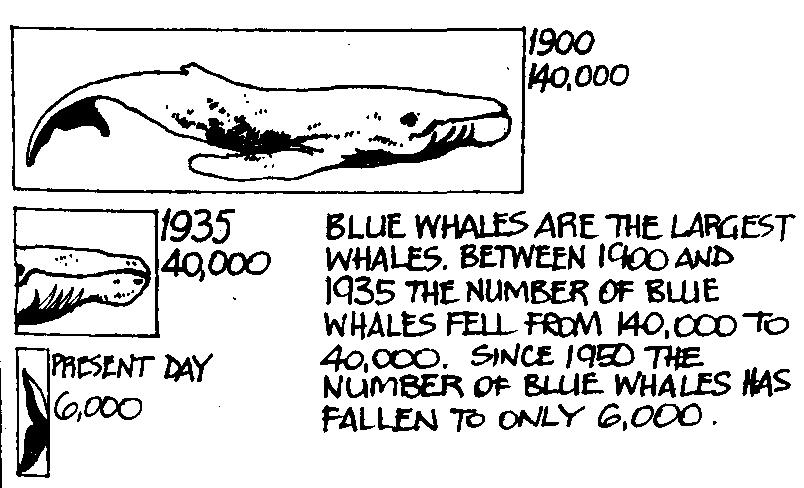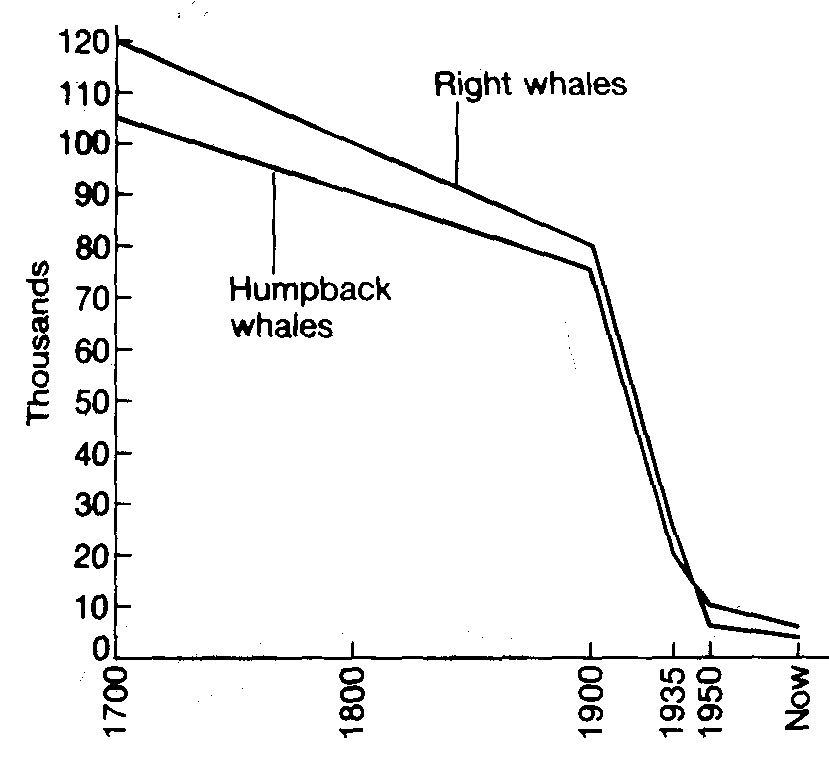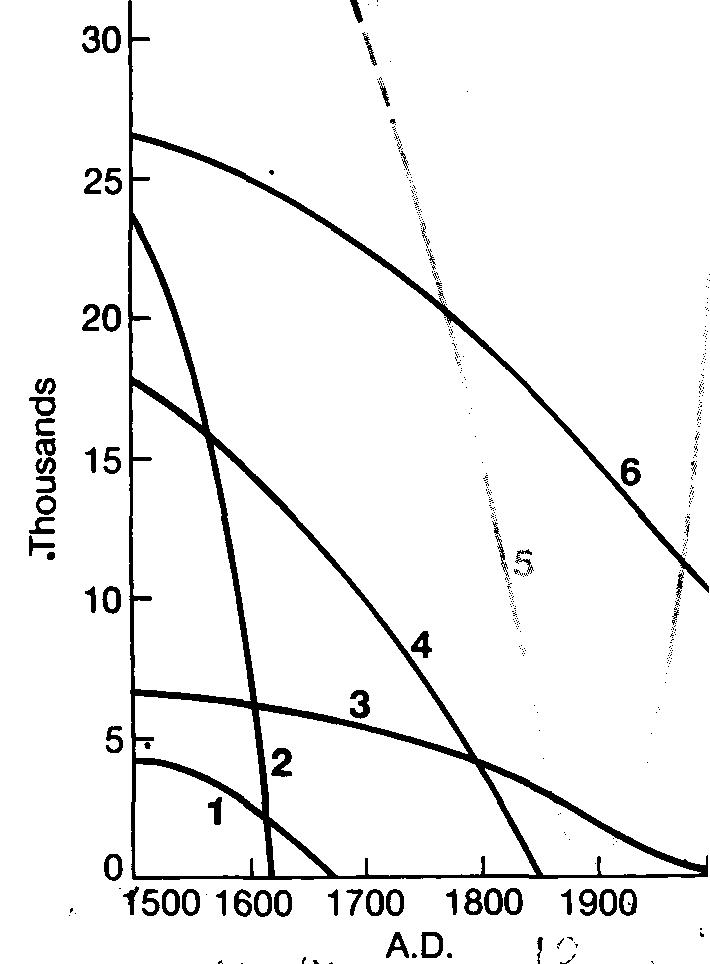
- •Посібник з розвитку навичок читання та говоріння
- •Contents
- •Do you worry about the environment?
- •Now add up your score
- •Environmental pollution
- •Vocabulary
- •Kinds of pollution Part I
- •Vocabulary
- •Kinds of pollution Part II
- •Vocabulary
- •Water pollution
- •Vocabulary
- •Causes of pollution
- •Vocabulary
- •Controlling pollution
- •Vocabulary
- •Vanishing animals
- •Vocabulary
- •Language snack
- •Trees in danger
- •Vocabulary
- •Example
- •Example
- •The environment and pollution in great britain
- •Vocabulary
- •The attack on britain’s environment
- •Vocabularly
- •Air pollution
- •Noise pollution
- •Water pollution
- •Cars and Roads
- •The environmental movement in the usa
- •Vocabulary
- •Investigate appear is disturb
- •Fighting extinction
- •Vocabulary
- •Література
Vanishing animals
Vocabulary
vanish зникати
extinct вимерлий, зниклий
aurochs зубр
dodo дронт вимерлий (птах)
parakeet довгохвостий папуга
habitat місце поширення, природне
середовище
drainage дренаж
quail перепел, куропатка
succumb to не витримати, не вистояти,
загинути від
hunt полювати, ловля
predator хижак
carnivore плотоядна тварина
marsupial зоол. сумчаста тварина
nocturnal нічний
apteryx безкрил (нелітаюча
птаха)
persicute переслідувати
wipe out знищувати
weasel горностай, ласка
threaten загрожувати
oryx антилопа, бейза, сернобик
rhinoceros носоріг
whooping crane журавель-кликун
crested ibis прикрашений гребнем
(з чубком) ібіс
kite коршун
whale кит
harpoon гарпун
humpback горбач, горбатий кит
Reading Read and say about animals vanished in the past three centures.
Vinzenz Ziswiler, a Swiss ecologist, in his book Extinct and Vanishing Species, lists about 150 species known to have vanished in the past three centuries. The list ranges from the aurochs 1627) and the dock? in the seventeenth century, to the Indian pink-headed duck in 1944. The reasons why animals vanish from the earth are various: the Tahitian (parakeet went because its habitat was altered by drainage. The New Zealand quail succumbed to diseases introduced by settlers. The Tasmanian wolf was hunted because it was ignorantly believed to be a predator - actually it is not a carnivore, but a marsupial like the kangaroo.
The nocturnal kiwi or apteryx was wiped out by weasels introduced to 'enrich' the fauna of New Zealand. Schomburgk's deer was persecuted in Siam for religious reasons.
It is too late to do anything about these 150 vanished species, but we could do something about the 240 further species currently threatened with extinction. These include the Bactrian camel (400 left), the oryx (200), the Sumatra rhinoceros (170), the Cape zebra (75), the whooping crane (50), the Japanese crested ibis (12), the Everglades kite (15), the Bali tiger i(3 or 4) and others for which the numbers are not known.
Animals also still have much to teach. Thus the vanishing oryx can live indefinitely without drinking: hence it might become of great importance as a protein source in arid areas, as the growing world population expands into them. Who knows what future peoples will want?

Language snack
since/for + present perfect tense
Since |
1900 the 18th century |
} |
since is used with a point of time. |
For |
thousands of years two weeks |
} |
for is used with a period of time. |
Exercise 1. “Since” or “for”?
………… two hundred years ………… yesterday
…………1983 ………… two days
………… one hour ………… twelve minutes
………… the nineteenth century ………… 1492
………… two o'clock ………… Wednesday
Exercise 2. Look at the graph about blue whales. Put the correct verb in the following sentences.
Use: fell, has fallen, rose, has risen.
Since the eighteenth century the number of whales_________ .
Between 1930 and 1950 the number of blue whales _________ to only 21,000.
Since 1900 the number of blue whales _________ from 145,000 to only 6000.
In the eighteenth century the number of whale hunters _________ .
Since 1970 the number of non-whale hunting countries _______.
Exercise 3. Blue whales are only one kind of whale.
a) Read this information about humpback and right whales.
We do not know exactly how many whales there are in the sea because we cannot count them. But we believe at the beginning of the eighteenth century there were 105,000 humpback whales and 120,000 right whales. At the beginning of the twentieth century there were 75,000 humpbacks and 80,000 rights. Since 1900 their numbers have fallen very quickly. Between 1935 and 1950 the number of humpbacks fell from 20,000 to 10,000 and since 1950 the number has fallen to only 6,000. The number of right whales has fallen faster. In 1935 there were 25,000. The number fell to 6,000 in 1950 and since 1950 the number has fallen to 4,000.
b) Draw a graph to show what has happened

Exercise 4. Men have always been hunters. Thousands of animals have become extinct. But people have saved some animals.
a) Look at the graph.

b) Read and match the graphs to the names of the animals.
When men from Europe arrived on the island of Mauritius (That's M-A-U-R-I-T-I-U-S) they found a large bird there. They called it the Dodo. That was in 1507. In 1681 someone killed the last dodo.
Until the 18th century there were millions of American bison. In 1890 there were only 500. Fortunately the government stopped hunting at the beginning of the twentieth century. Since then the number of bison has risen to 25,000.
The aurochs, or European bison, was not as lucky as its American brother. The last aurochs died in 1627.
The tarpan, a wild European horse, went the same way as the aurochs in 1851.
The Arabian Oryx was almost extinct in 1961 and it is still in danger. Since 1961 the number of oryx has risen but there are still only 80 in the world.
Many animals are in danger today. The number of orangutans has fallen to only 10,000.
We must save these animals. We can do it. We have done it with the American bison. We don't want any more dodos.
Cues: tarpan, aurochs, dodo, Arabian oryx, orangutan, American bison.
c) Work in pairs. Ask and answer about these animals.
Example 1.
A Has the ______ become extinct?
B Yes, it has.
A How long has it been extinct?
B It's been extinct since _____
OR
It's been extinct for ______ years.
Example 2.
A Has the ______ become extinct?
B No, it hasn't.
A How many are there now?
B ______.
Exercise 5. What are these animals?
1 |
oymekn …………. |
5 |
griet …………. |
8 |
thrcsoi …………. |
2 |
hawel …………. |
6 |
ilorlag …………. |
9 |
breza …………. |
3 |
sonbi …………. |
7 |
roshe …………. |
10 |
nepugni …………. |
4 |
tanlepeh …………. |
|
|
|
|
Exercise 6. Crossword. The answers are the past participles of these verbs.
|
|
|
|
|
|
|
|
|
|
|
|
|
|
|
|
|
1 |
|
|
|
|
|
|
|
|
|
|
|
|
|
2 |
|
|
|
|
|
|
|
|
|
|
|
|
|
|
|
|
|
3 |
|
4 |
|
|
|
|
|
|
|
|
|
|
|
|
|
|
|
|
|
|
|
|
|
|
|
|
|
|
|
|
5 |
|
|
|
|
|
|
|
|
|
|
|
|
|
|
|
|
|
|
|
|
|
|
|
|
|
|
|
|
|
|
|
|
|
|
|
|
|
|
|
|
|
|
|
|
|
|
|
|
|
|
|
|
|
|
7 |
|
|
|
|
|
|
|
|
|
|
|
|
|
|
|
|
|
|
|
|
|
|
|
|
|
|
|
|
|
|
|
|
|
|
8 |
|
9 |
|
|
|
10 |
|
|
|
11 |
|
|
|
|
|
|
|
|
|
|
|
|
|
|
|
|
|
|
|
|
|
|
|
|
12 |
|
|
|
|
13 |
|
|
|
|
|
|
|
|
14 |
15 |
|
|
|
|
|
|
|
|
|
|
|
|
|
|
|
|
|
|
|
|
|
|
|
|
|
|
|
|
|
|
|
16 |
|
|
|
|
|
|
|
|
|
17 |
|
|
|
|
|
|
|
|
|
|
|
|
|
|
18 |
|
|
|
|
|
|
|
|
|
|
|
|
|
|
|
|
|
|
|
|
|
|
|
|
|
|
|
|
|
|
|
|
|
|
|
|
|
|
|
|
|
|
|
|
|
|
Across |
3 |
rise |
Down |
1 |
land |
|
5 |
buy |
|
2 |
write |
|
7 |
take |
|
4 |
stay |
|
9 |
live |
|
6 |
fall |
|
12 |
be |
|
8 |
see |
|
13 |
go |
|
10 |
do |
|
14 |
break |
|
11 |
find |
|
16 |
draw |
|
12 |
become |
|
18 |
make |
|
15 |
run |
|
|
|
|
17 |
leave |
Exercise 7. Complete the gaps witch the words from the text.
The … why animals vanish from the earth are various.
The Tahitian parakeet went because its habitat was altered by …
The new Zealand quail succumbed to … introduced by settlers.
The apteryx was wiped out by weasels introduced to “enrich” … of New Zealand.
Exercise 8. Answer the questions.
How many species known to have vanished in the past three centures does Vinzenz Ziswiller list?
How many species are currently threatened with extinction?
What animals are becoming extinct?
Lesson 8
